Replacing a seized caliper on my son’s crap-can Corolla

My 29-year-old youngest son, Aaron, owns a silver 2007 Toyota Corolla LE. It’s the poster child for reliability and ease of operation—if ever there was a car whose design goal was to allow any grandmother to rent one and instantly be able to turn on the heat or A/C, it’s this one. It’s the poster child for, well, boredom. The reaction I have whenever I drive the car is that if I had to road-trip it even back and forth to New York, I’d feel like a like a coyote in a trap that would gnaw off its own foot to get free.
That having been said, I have a soft spot for the car, because speaking of grandmothers, that’s where Aaron got it—my mother gifted it to him before she passed in 2019. And, in fact, I was the one who procured the car for her. She had proudly been a “five-speed granny” until her arthritis caught up with her at age 84 and she asked me to find her an automatic. In one of those big circle of life things, Aaron had been living in our old apartment on the third floor of my mother’s house in Boston (where my wife and I lived from 1984–92 before we moved to our current house in Newton), and he would still be living there if my sister—who lived there with my mother for 40 years—hadn’t decided (and reasonably so) that it was time to sell the house and move into something that had fewer stairs and needed less upkeep. So, yeah, my sister and I evicted my son from my mother’s house. He moved back in with us to save money before striking back out on his own.
With all that context, you can probably appreciate that I’m not only happy to have Aaron living with us, but that the sight of the little silver Corolla in front of the house makes me smile. For a moment, I can pretend that my mother drove over here for a visit.
Because she used the car mainly for errands, and Aaron had a short commute to his job two towns over (now one), the car has only 88,000 miles on it. However, New England winters have begun to take their toll, and a large rust spot is forming on the left rear fender lip. At some point this will make the car un-inspectable. But we’re not there yet, and the Corolla soldiers on, receiving little attention and zero preventive maintenance, and it is taking the abuse remarkably well, as it was designed to do.
Aaron was planning to go camping in northern Maine with his two brothers. They had a staggered departure schedule—the other two left the day before in my wife’s Honda Fit, and Aaron was leaving in the Corolla the following morning. But when he got home from work at dusk that evening, he said that the right rear tire began rapidly losing air on his three-mile drive home from work. I looked at it and found what turned out to be a car key stuck in the inside edge of the tread. I could hear the air hissing past it.

This was a problem. The fact that the puncture impinged on the sidewall would almost certainly make any tire shop refuse to patch it. And the car didn’t have a full-sized spare, just a donut—definitely not something you want to put 600 highway miles on. And he had a boat to catch at 2 p.m., necessitating a 10 a.m. departure.
We stepped through the options. I jumped on Craigslist and Facebook Marketplace trying to thread the needle looking for a good 195/65R15 tire on a compatible 5×100 45mm offset wheel with a 54.1mm center bore, and found none. (Actually, the Corolla has a set of execrable Pep Boys-type aftermarket alloys, the type with both a 5×100 and a 5×120 bolt circle. Where they came from, I have no idea, as they weren’t on it when I got the car for my mother. In addition, they host four mismatched tires. So I really hoped I could score a whole set of proper wheels and decent tires for Aaron, but sadly it was not to be.)
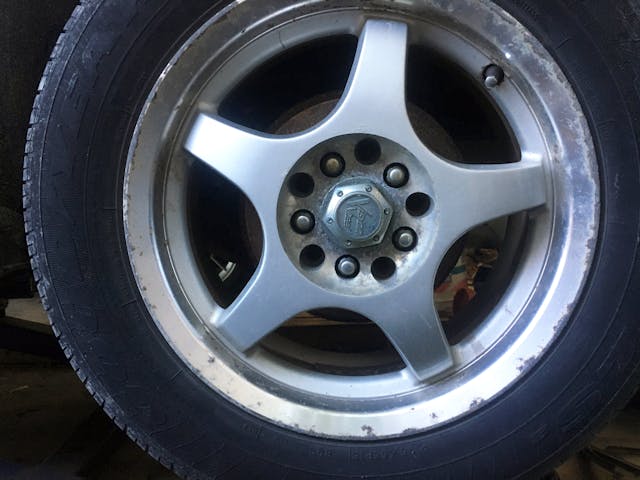
I called a friend who owns a mobile tire mounting and balancing business and asked if he could bail us out with one tire, but he said he didn’t have that size tire in stock and probably couldn’t get one and get over to the house until mid-morning. Aaron is the only one of my three kids who never learned how to drive a stick (he had a single lesson eight years ago in my Z3, where the combination of a parked car, an aggressive oncoming driver, and pedal confusion spooked him), so despite all the cars in the driveway, the only automatic vehicle I could offer him was the monstrously large Chevy 3500HD dually diesel with the utility body. This wasn’t out of the question, but the fuel cost was daunting.
We checked online and found that a nearby Sullivan Tire opened at 7:30 a.m. I advised that the best thing to do was pull the troublesome wheel and tire off the Corolla and mount the spare. This would let him run the loose wheel over to Sullivan, which might be faster than requiring a service bay to jack up the car. It all took longer than he’d hoped, but by about 10:30 that morning he was back home with a new tire on the wheel. I threw it on the car, and he was on his way. He was late for his boat, but managed to catch another one. It all worked out.
When Aaron got home five days later, I asked if there were any other mishaps with the car. He laughed.
“Well,” he said, “funny story …”
Having nothing to do with the flat tire, the car’s left front caliper was seizing. He knew that was the problem because the same thing had happened to the right front caliper last year. The car was pulling lightly to the side of the stuck caliper while driving, pulling more strongly to the other side while braking. Plus, the brake pad smelled, there was a bit of a chattering sound, and the wheel was hot to the touch. He said it started happening about 50 miles from home, and he thought about bagging it and called for a tow, but instead he stopped, let it cool down, then drove carefully in the right lane.
I don’t include seized brake calipers on my “Big Seven” list of things likely to strand a vintage car on a road trip because it’s not a terribly common occurrence in the vintage BMW world in which I live. I’ve only had it happen once, and oddly, enough, that was on what for me is a relatively new car—my 1999 M Coupe (“the clown shoe”). A seizing rear caliper doesn’t pull the car to one side the way it does when one of the fronts is seized; it’s the smell and the chattering that alerts you while you’re driving. The hot wheel is the confirming symptom. If this happens to you, be aware that the wheel can be so hot that you can easily burn your hand if you blithely press your palm or fingers on it. It’s better to let your palm hover half an inch away, or fold a paper towel over a few times and interpose it.
However, there’s something else that can cause these same symptoms—a clogged or swollen flexible brake line. The brakes on nearly every car use hard metal lines running from the master cylinder to the wheels, but because the wheels (and with them, the calipers, rotors, and pads) move up and down along with the suspension, a flexible section of brake line—usually a rubber hose—is employed to accommodate the motion. The flexible line may connect directly to the caliper, or may sit between two hard metal lines. In either case, if the flexible line is clogged, fluid can’t pass to or return from the caliper, and the symptom can be difficult to distinguish from that of the caliper being seized.

The definitive test is to pull the caliper off the strut and squeeze the piston(s) with a big pair of slip-joint pliers. If the pistons don’t move, then you’ve caught the seized caliper red-handed, but if they’re free, then the caliper isn’t the problem. A less-invasive way to triage whether the problem is due to the caliper or the flexible hose is to open up the bleed valve at the caliper. If fluid doesn’t flow out and the bleed valve itself isn’t plugged, either connect a pressure bleeder to the brake reservoir or have someone gently depress the brake pedal. If there’s still no fluid flow, then it’s likely that the flexible line is clogged or swollen shut. Of course, if the car is one that’s been sitting for decades, you’d automatically replace the flexible brake lines and probably the calipers as well during the rejuvenation process. On a not-as-ancient car, if the flexible lines are rock-hard and cracked, and you’re replacing the calipers anyway, it’s a good while-you’re-in-there task.
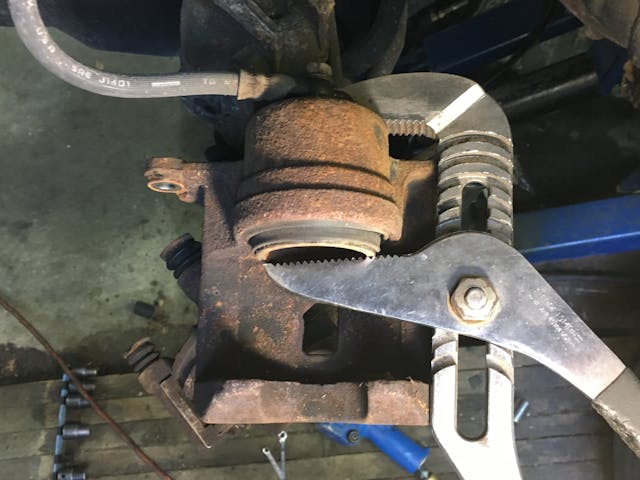
I’ve written for Hagerty and also in my first book about what I call “the rhythm of repair.” The issue is that if you bring a car into a dealership for a repair, they likely have every part it needs or can get them in short order, so they lay the car up in a service bay, take the problem area apart, assess the situation, make a list of parts, bring them to the car, then fix the problem. You are a DIY-er, however, not a dealership. So you make an educated guess.
In a perfect world, you know from the symptoms which parts you need to order. When they arrive, you jack up the car, pull the old parts out, install the new parts—boom, done. However, we don’t always live in that world. It’s common to start a repair and find out that you need more than just the parts you ordered. Maybe you have a used set of calipers around as well as a set of enough-meat-on-them-that-you-didn’t-throw-them-out brake pads, but the odds of you having every clip, spring, bolt, and backing plate a brake job might require are close to zero. If you need to order parts twice and wait for delivery, it virtually guarantees that the car will be laid up for a week.
Fortunately, a 2007 Corolla is a far cry from the 1970s BMWs and Lotus Europa that I usually work on. Automotive chains like Autozone are likely to carry many normal wear-and-tear parts. If they don’t, a trip to a dealership is likely to be productive, though more expensive.
I explained to Aaron about how brake work is usually done on both left and right sides, and thus, if this was my car, I’d probably replace both front calipers, and while I was in there would also do the pads and rotors and the flex lines if the rubber was hardened and cracked. I jumped on Rockauto.com and looked up brake parts for the car. The costs of rebuilt versus new Raybestos calipers were both about $60 per side. Two calipers, a set of rotors, and pads came to about $200 shipped. Flexible brake hoses were about an additional $18. However, Aaron said that in addition to the right front caliper having been recently replaced, he’d had the rotors and pads done not long before that. I shined a flashlight through the wheel and gave a cursory examination. The pads looked thick, and there was nothing cringeworthy about the rotors. I reached around the back of the wheel and grabbed the flexible brake line. It felt supple to me. He opted to take the inexpensive route—one caliper, shipped, for $68.44. I can’t say that I protested. My back is still giving me fits, and pulling one fewer wheel, one fewer caliper, and two fewer rotors was fine with me as long as it resulted in a safe car.
The next day, I moved the four cars that were in the way—the ’72 2002tii and the M Coupe that were in the garage, and the Z3 and my daily-driver 530i that were in the driveway—and cleared the most hallowed spot of all, the mid-rise lift, to receive the sh*tbox. As I drove the car into position, I could hear a bit of grinding from the left front. With the car on the lift, I put it in neutral and manually spun both front wheels. The right spun free, but the left was very difficult to turn. It sure felt like a stuck caliper.
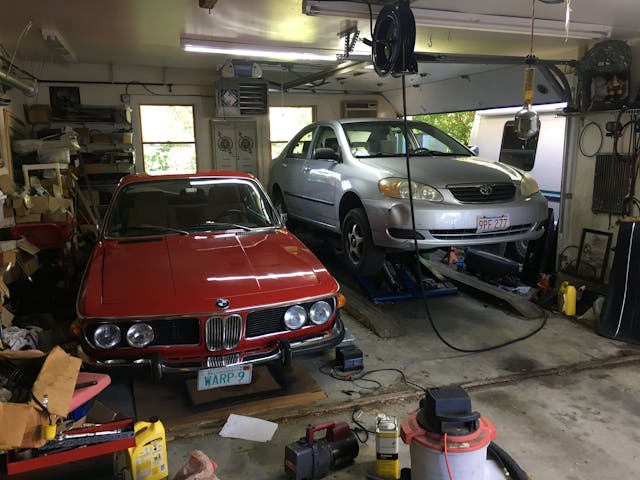
I pulled the wheel off and had my first detailed look-see at what I was about to replace. The caliper was the kind of single-piston single-line unit that most modern cars use, with a slider bracket bolted to the MacPherson strut. A long rubber flexible line connected directly to the back of the caliper.
I thought about pulling the caliper off, but a) I really avoid disabling a car until I’m certain I have the correct replacement part in hand, and b) I noticed that the flex line was connected to the caliper with a banjo bolt. Unlike an old-school directly threaded-in brake line, there was no easy way to plug this, so if I disconnected it, it would drip brake fluid until it emptied the reservoir and the master cylinder. No, the thing to do was leave it connected until the new caliper was installed.
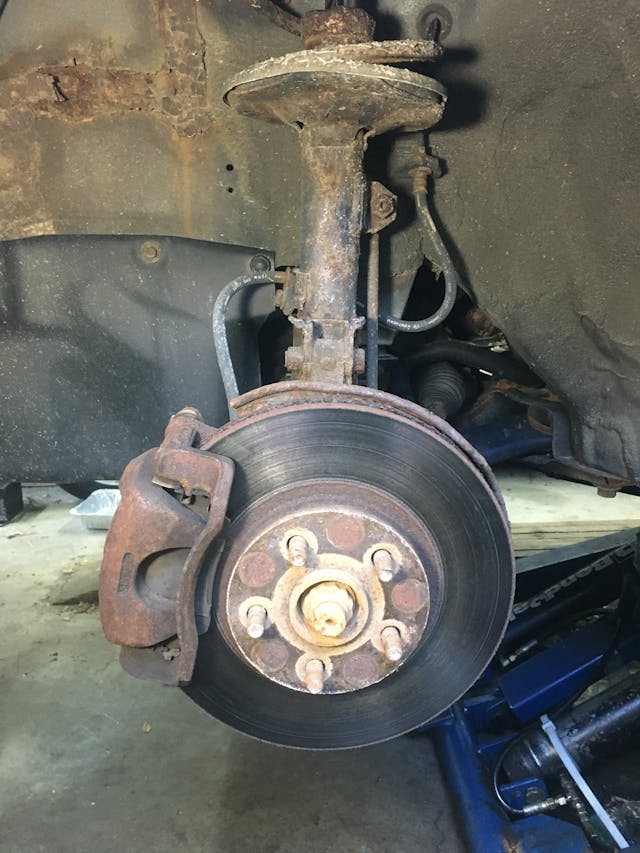
A few days later, the replacement caliper arrived, and I had at the repair. No, I didn’t rope Aaron into helping. This was a practical efficient utilitarian task, slotted in while he was at work. He’s a great kid who helps his mother and me in any number of ways. I didn’t need this to be one of them. I was perfectly happy to do it for him.
First, I visually examined the new caliper and verified that it appeared to be the same part currently on the car. I was pleased to find that it came with a new bracket, as some require you to reuse the original one currently on the car.

To minimize brake fluid loss, I left the old caliper connected to the brake line while I transferred the brake pads to the new caliper and installed it on the strut, then undid the banjo bolt and transferred the line over to the new caliper. I assumed I’d need to use my Motive pressure bleeder to get the air out of the caliper, but I realized that I didn’t have the adapter for a Japanese car. I was resigned that I’d need to wait until Aaron got home to press him and his right leg into pedal-pumping service, but then thought I’d try gravity-bleeding the caliper. I’ve rarely had success with this on vintage BMWs with four pistons, two brake lines, and three bleed valves on each caliper, but on this simple modern caliper, it worked perfectly.
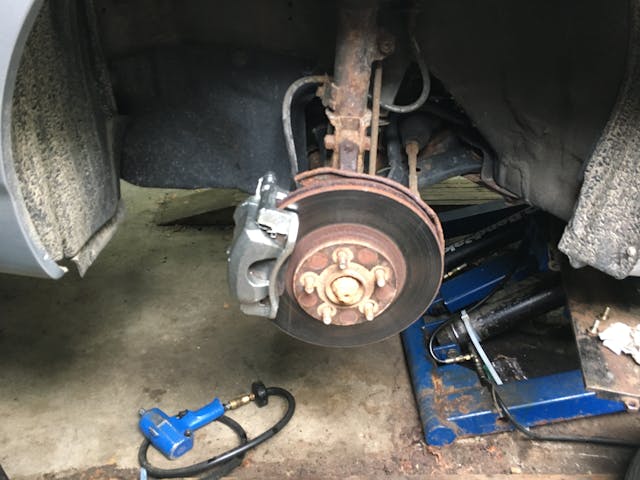
A quick test drive revealed absolutely no problems—even braking, no soft pedal, no pull, no chatter.
So, for $68.44 and a few hours of my time, my mother’s car continues to serve my youngest son.
And yes, to avoid a repeat episode of being boxed in like this, Aaron has consented to let me try to again teach him to drive a stick.
Now if only I could do something about those wheels.
***
Rob’s latest book, The Best Of The Hack Mechanic™: 35 years of hacks, kluges, and assorted automotive mayhem is available on Amazon here. His other seven books are available here on Amazon, or you can order personally-inscribed copies from Rob’s website, www.robsiegel.com.
Check out the Hagerty Media homepage so you don’t miss a single story, or better yet, bookmark it. To get our best stories delivered right to your inbox, subscribe to our newsletters.
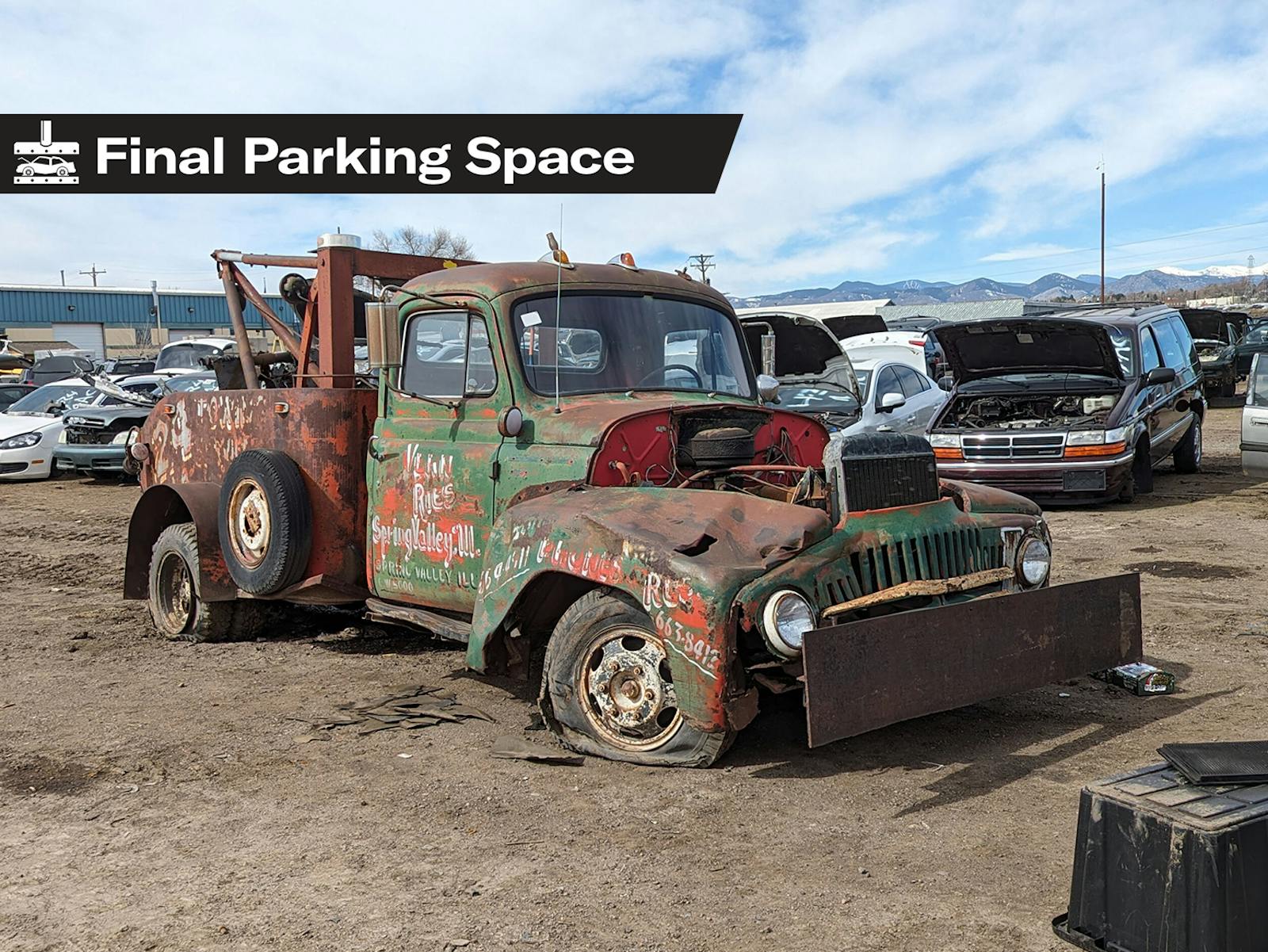
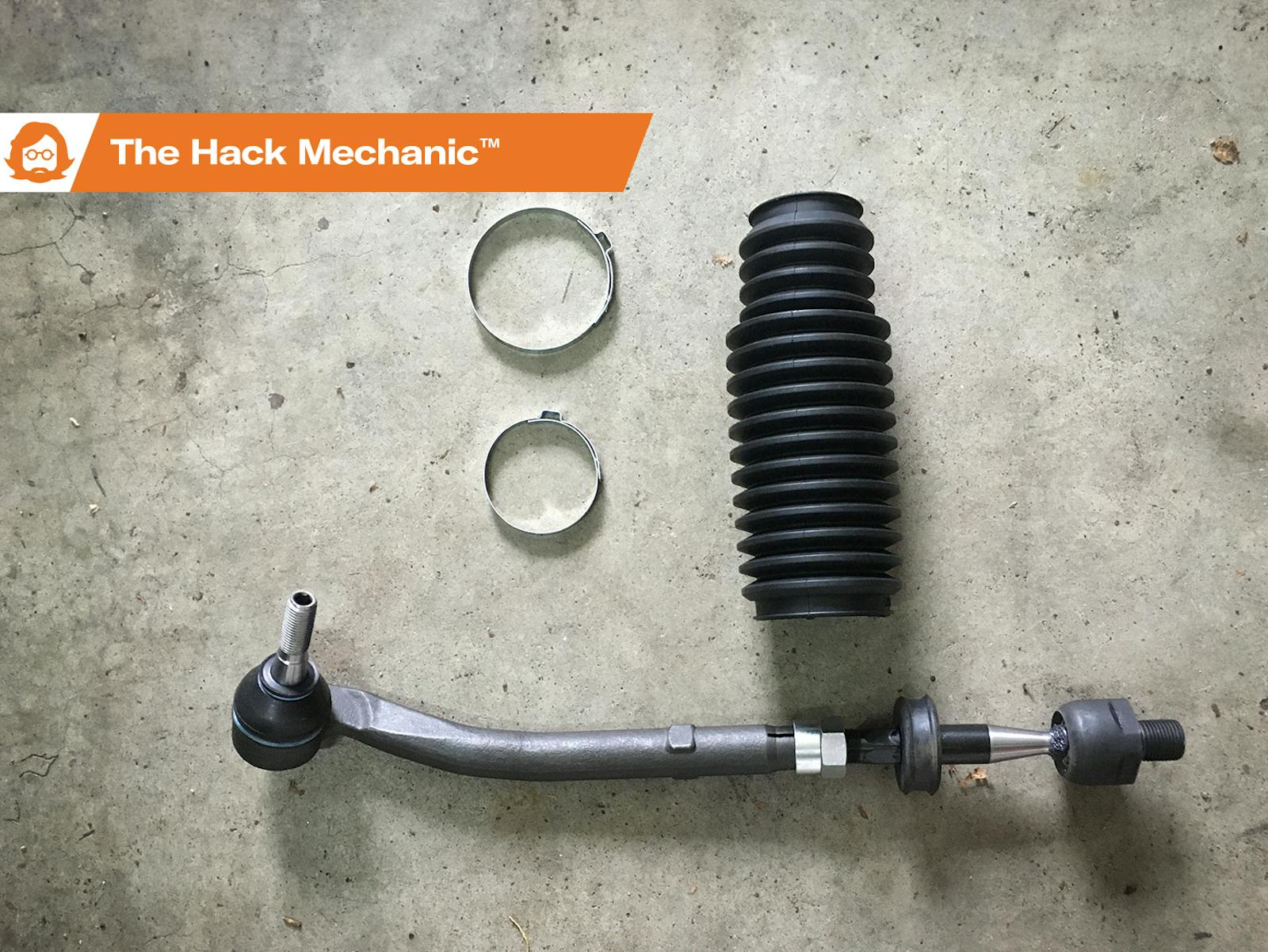
About 10-15 years ago, I made pumping some fresh brake fluid through my brake lines on a bi-annual basis a part of regular maintenance.
I have not had to replace a caliper since. Can’t say it will cure all seized caliper problems, but the difference in my repairs before and after is stark.
Love your articles Rob. I have to take issue with your comment “sh*tbox”. I will take a Toyota product over a BMW any day. Your tales of trials and tribulations about fixing your troubled BMW’s alway amuse me. I get it. You like a challenge, and they do server you well as “content generators”.
In the real world, I would rather have a vehicle, that does not generate “content”. I have owned Fords, GM, Fiat, VW, and even an Opel (2). After purchasing a used Toyota Tercel, (Yes, a Tercel for work), I was so impressed with the quality of build, even for an economy car, that I never have had any thing else. I currently own a Lexus, and it is a great car. It may not be that much fun to drive, but that is what my five speed Mustang is for….
Keep the great stories coming Rob. And my sympathies go out to your BMW suffering.
I agree.Have a 1999 LS400 and a 2006 Scion xb gen 1.Toyota bookends and the best cars Toyota ever made.Both excel in their genre.I dont need content.I need starts,runs,and uber reliable.I know my wife wont be stranded.
And Rob,love your stories,such great automotive reads.